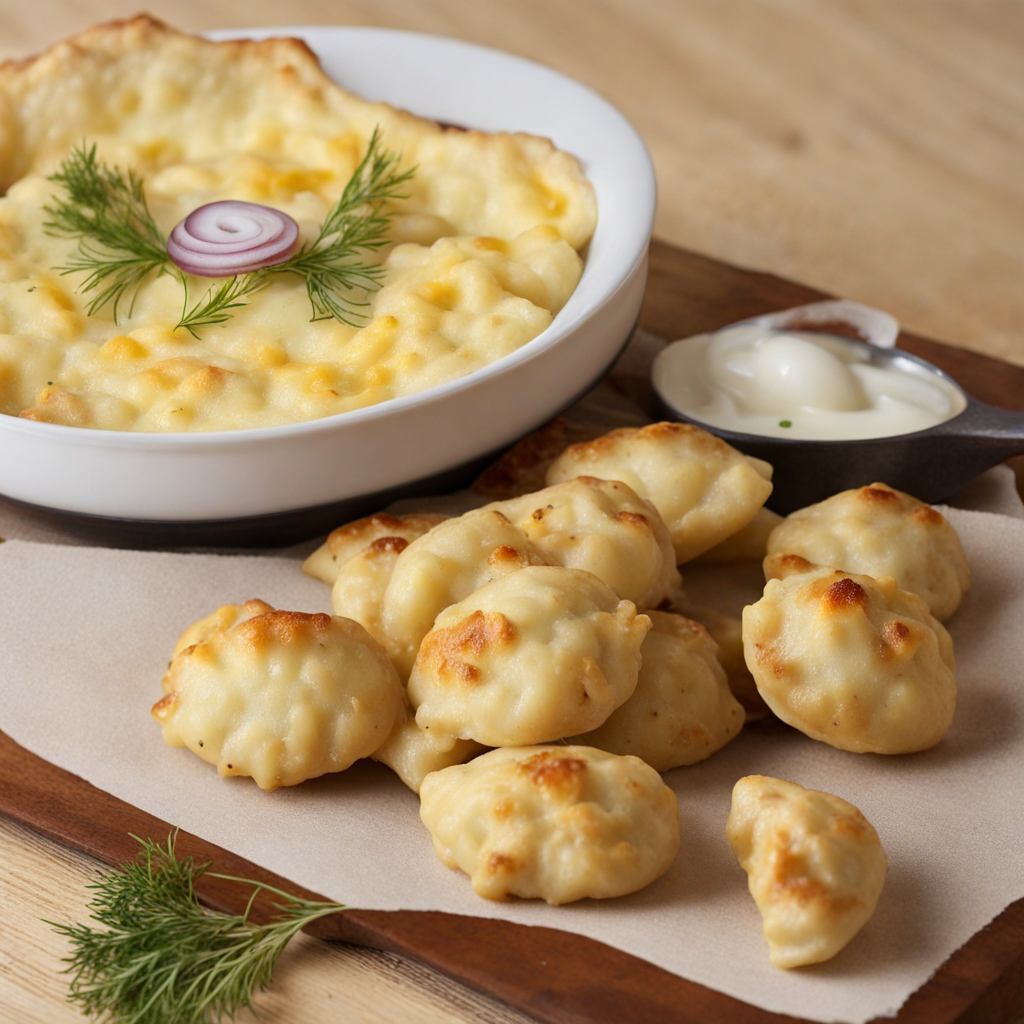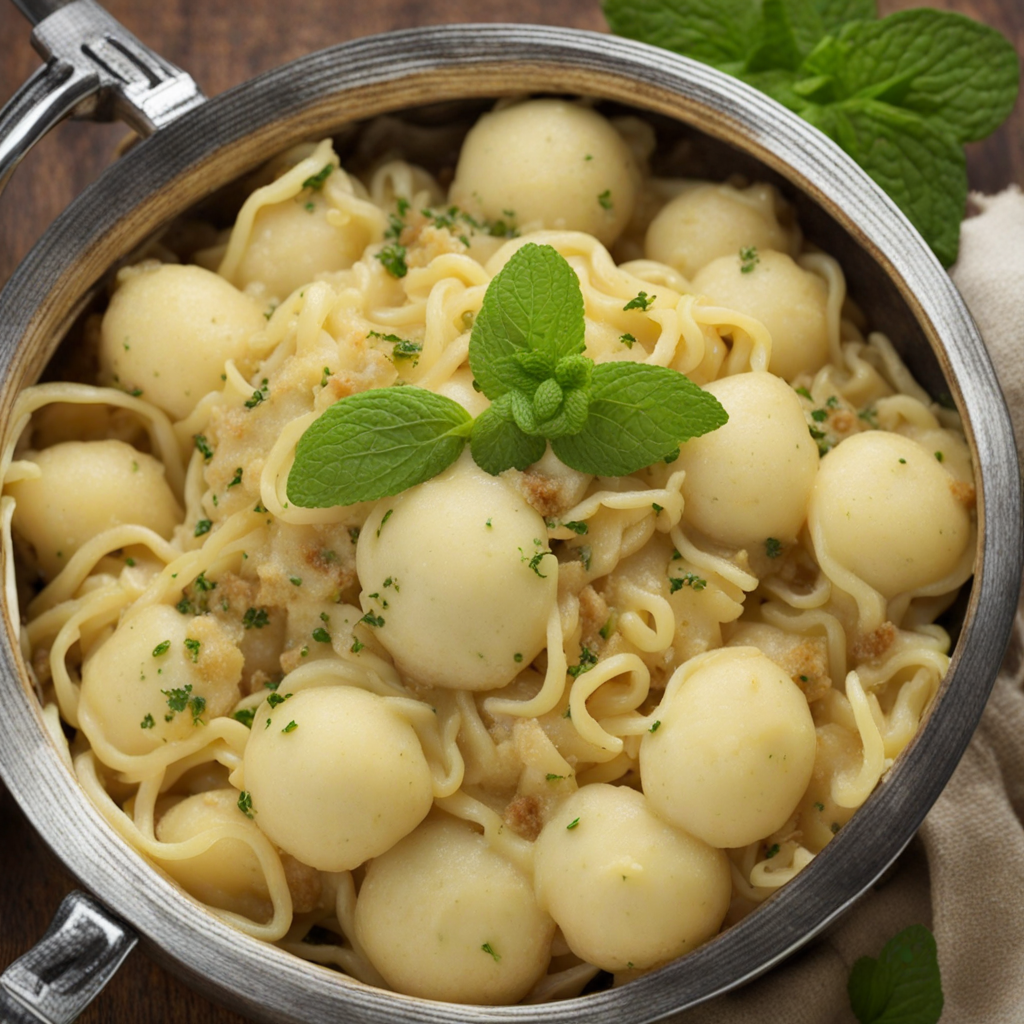Pinzgauer Kasnocken
Pinzgauer Kasnocken is a delightful dish hailing from the scenic Pinzgau region of Austria, known for its stunning alpine landscapes and rich culinary traditions. This hearty dish primarily consists of hand-rolled dumplings made from a simple yet flavorful mixture of flour, eggs, and curd cheese, which brings a unique tanginess to each bite. The dumplings are typically shaped into small, irregular pieces, allowing for a rustic charm and a satisfying texture that pairs beautifully with various accompaniments. The cooking process of Pinzgauer Kasnocken involves boiling the dumplings until they are tender and lightly chewy, then pan-frying them to achieve a golden-brown crust. This dual cooking method enhances the overall flavor, giving the dish a delightful contrast between the soft interior and the crispy exterior. Often served with a generous helping of melted butter, crispy onions, and fresh herbs, Kasnocken can also be elevated with the addition of sautéed mushrooms or seasonal vegetables for an extra layer of taste. What sets Pinzgauer Kasnocken apart is its versatility and comfort-food appeal. Traditionally enjoyed as a main course, it can also serve as a side dish, complementing roasted meats or stews. Each bite embodies the essence of Austrian alpine comfort, making it a warm and inviting dish perfect for sharing with family and friends. For those looking to explore new tastes, Pinzgauer Kasnocken offers a delicious journey into the heart of Austrian cuisine, where simple ingredients are transformed into an unforgettable culinary experience.
How It Became This Dish
Pinzgauer Kasnocken: A Culinary Journey Through Austria's Alps Nestled within the picturesque landscapes of Austria’s Pinzgau region lies a dish that encapsulates the essence of Alpine cuisine: Pinzgauer Kasnocken. This traditional Austrian delicacy, often described as a type of dumpling or pasta, reflects not only the agricultural bounty of the region but also the rich tapestry of cultural influences, local customs, and historical context that have shaped the foodways of this mountainous area. Origins of Kasnocken The origins of Kasnocken can be traced back to the farming communities of the Pinzgau region, which is located in the state of Salzburg. This area, known for its lush pastures and alpine meadows, has long been a hub for dairy farming. The production of cheese, particularly the semi-hard varieties, is a significant aspect of the local economy and culinary practices. Kasnocken itself is believed to have emerged as a way to utilize leftover cheese, a common practice in many rural communities where resourcefulness was vital for survival. The word "Kasnocken" can be broken down into "Kas," which means cheese in the local dialect, and "Nocken," meaning small dumplings or lumps. The dish typically consists of a dough made from flour, eggs, and soft cheese, often mixed with potatoes, which is then cut into small pieces and boiled. Traditionally, it is served with a deliciously rich butter sauce and garnished with crispy onions or herbs. Cultural Significance Food in the Pinzgau region is deeply intertwined with local culture and identity. Kasnocken is not just a meal; it is a symbol of communal gatherings and celebrations. This dish is often prepared during festive occasions, family gatherings, and traditional holidays. Its preparation and consumption are associated with a sense of togetherness, reflecting the communal spirit prevalent in Austrian alpine culture. Furthermore, Kasnocken embodies the concept of “Alm,” which refers to the seasonal migration of livestock to high pastures during the summer months. As families moved their herds to the Alps, they adapted their cooking methods to utilize the ingredients available in the highlands. This seasonal way of life significantly influenced the ingredients used in local dishes, and Kasnocken became a staple food for shepherds and farmers who needed hearty sustenance during long days in the mountains. Development Over Time As with many traditional dishes, the preparation and presentation of Kasnocken have evolved over time. The earliest versions were likely quite simple, utilizing only flour, water, and local cheese. However, as culinary practices developed, variations began to emerge. Today, you might find Kasnocken made with various types of cheese, such as the famous Pinzgauer cheese, a semi-hard cow's milk cheese that adds a distinctive flavor to the dish. In the late 19th and early 20th centuries, as tourism began to flourish in the Austrian Alps, Kasnocken found its way onto restaurant menus and became a favorite among visitors. This period marked a significant transformation in how traditional foods were perceived and consumed. What was once a humble farmer’s dish evolved into a symbol of Austrian cuisine, embraced by both locals and tourists alike. The post-World War II era saw a renewed interest in regional dishes as people sought to reconnect with their culinary heritage. In this context, Kasnocken gained popularity not only in Austria but also in neighboring countries. Chefs began to experiment with the dish, incorporating modern culinary techniques and presentation styles while still honoring its rustic roots. Contemporary Revival and Global Influence In the 21st century, the resurgence of interest in traditional and locally sourced foods has led to a revival of Kasnocken. Chefs and home cooks alike are rediscovering the joys of preparing this dish from scratch, often using artisanal cheeses and organic ingredients. Culinary festivals celebrating regional cuisine have also contributed to the dish’s popularity, allowing locals to showcase their culinary heritage while engaging with a broader audience. The globalization of food culture has also brought Kasnocken to international attention. As travelers explore the culinary offerings of Austria, they often seek out authentic experiences that connect them with the local culture. Social media has played a pivotal role in promoting traditional dishes like Kasnocken, with food bloggers and influencers sharing recipes and experiences that highlight its significance. Furthermore, the rise of vegetarian and comfort food trends has allowed Kasnocken to thrive in contemporary culinary contexts. As a hearty, cheese-filled dish, it appeals to those seeking satisfying and wholesome meals. Many restaurants now offer modern interpretations of Kasnocken, incorporating seasonal vegetables, gourmet sauces, or even fusion elements that reflect global culinary influences. Conclusion Pinzgauer Kasnocken stands as a testament to the rich culinary heritage of the Austrian Alps. From its humble origins as a farmer's dish to its status as a beloved staple in both local and international cuisine, it encapsulates the spirit of resourcefulness and community that defines the Pinzgau region. The dish not only nourishes the body but also serves as a bridge between generations, connecting the past with the present and inviting future generations to continue the tradition. As Austria continues to celebrate and promote its culinary heritage, Kasnocken will undoubtedly remain a cherished dish, embodying the flavors, culture, and history of this enchanting alpine region. Whether enjoyed in a rustic mountain hut or a modern restaurant, Pinzgauer Kasnocken is a delicious reminder of the enduring power of food to connect us with our roots and with one another.
You may like
Discover local flavors from Austria







